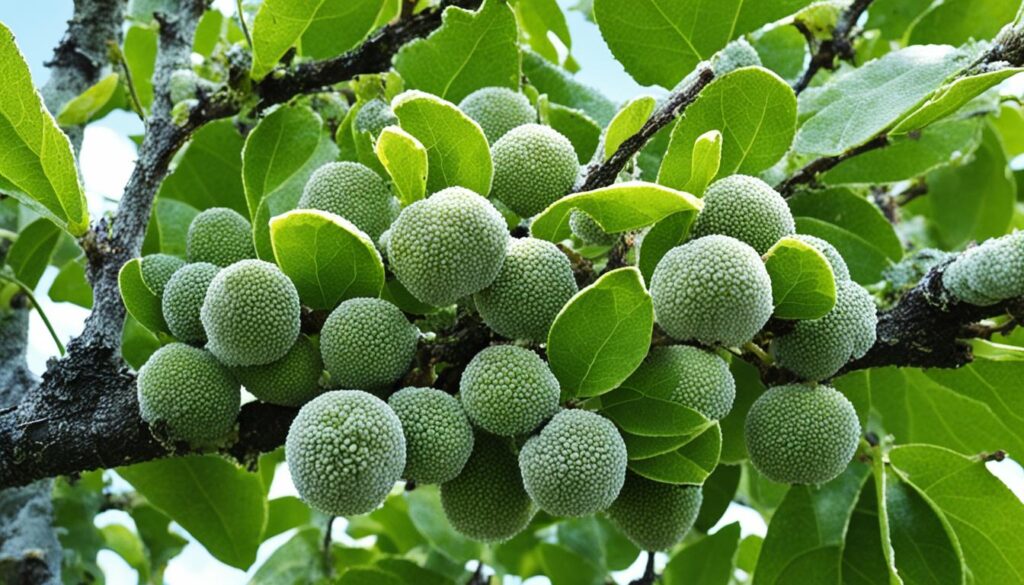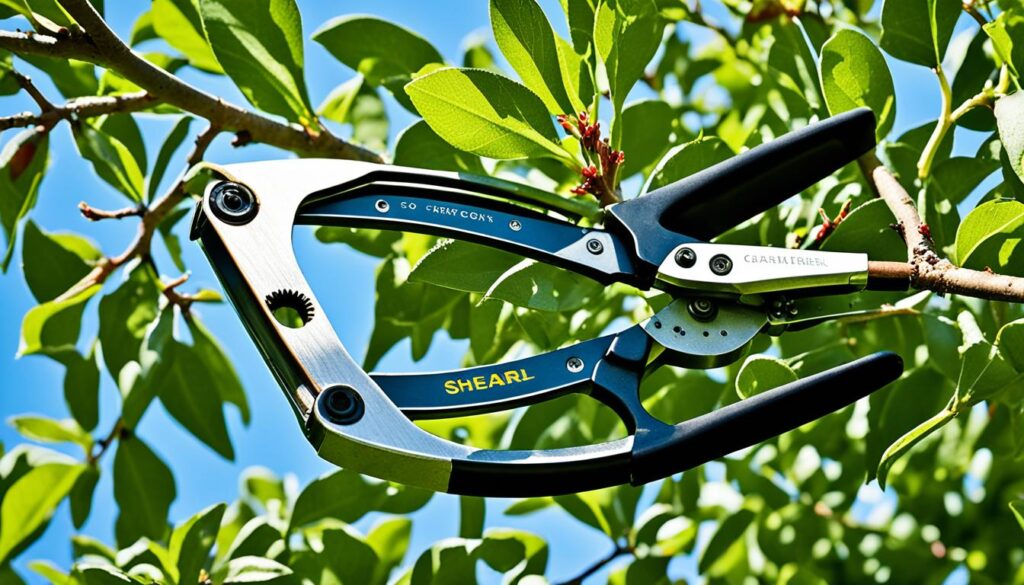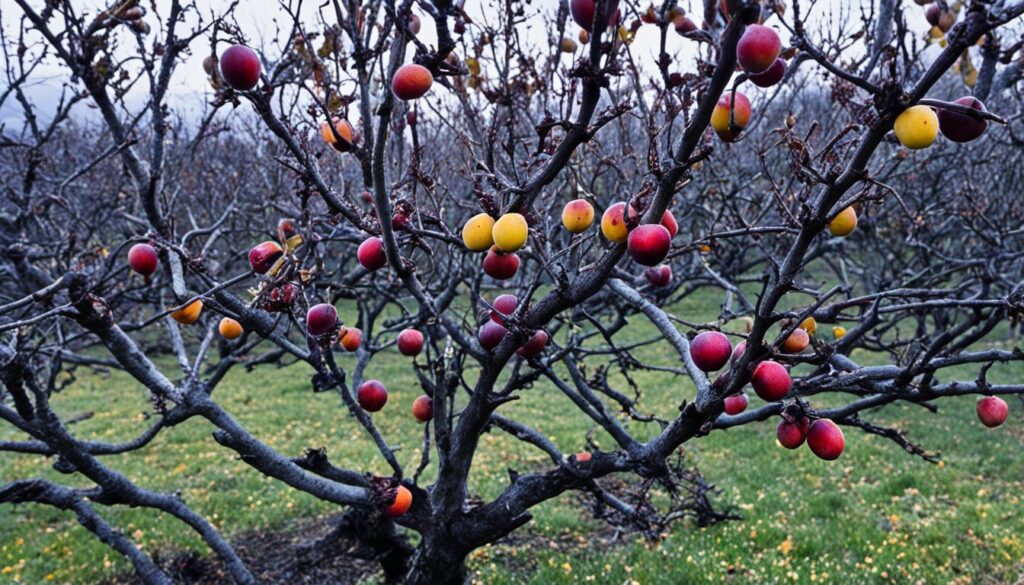Are your fruit trees showing signs of trouble like spots, lesions, or discolored leaves? These could mean your trees are facing common fruit tree diseases. But don’t worry, you can fight these problems with the right knowledge and actions. This will help keep your orchard healthy and full of fruit for many years.
This guide covers everything from fungal infections like apple scab and peach leaf curl to bacterial cankers and nutrient issues. You’ll learn how to spot these diseases, use effective control methods, and choose between organic and chemical treatments. This will help you keep your fruit trees healthy and productive.
Common Fungal Diseases Affecting Fruit Trees
Fungal diseases are a big threat to fruit trees. They can cause problems like apple scab, rust diseases, and peach leaf curl. It’s important to know how to deal with these diseases to keep your trees healthy.
Apple Scab Disease
Apple scab is a common disease caused by Venturia inaequalis. It makes leaves and fruit turn brown and can lead to early leaf drop and less fruit. Using fungicides at the right time is key to fighting this disease.
Rust Diseases
Rust diseases, like cedar-apple rust, affect apples and pears. They cause bright orange spots on leaves and can make trees lose a lot of leaves. Using fungicides early can help stop these diseases from spreading.
Peach Leaf Curl Disease
Peach leaf curl is caused by Taphrina deformans and affects peaches and nectarines. It makes leaves turn red, curl up, and then brown and fall off. Using fungicides on time is important to fight this disease.

Being careful and acting fast is important to keep your fruit trees healthy. Knowing about apple scab, rust diseases, and peach leaf curl helps you fight these diseases. This way, you can keep your orchard looking great and productive.
Preventing Fruit Tree Diseases
Keeping your fruit trees healthy is key to stopping diseases. This means mulching, weeding, and watering them right. It also means thinning branches on big trees for better air and light.
Maintaining Healthy Trees
When you plant new trees or fill in gaps, keep them about 10 meters apart. This helps stop diseases from spreading. Prune trees when it’s dry and nice outside to avoid spreading diseases.
Proper Tree Spacing and Pruning
Fruit gardening is getting more popular because people want tasty food and know where it comes from. But, diseases like brown rot and fire blight can hurt the quality and amount of fruit you get. It’s important to have full sun, good soil, enough water, and the right food for your trees.
Pruning at the right time helps stop diseases by letting air in and cutting out sick branches. Cleaning up leaves, prunings, and fruit that falls off helps stop diseases from coming back.

By keeping your fruit trees healthy, spreading them out, and pruning them, you can lower the chance of diseases. This way, you can have a big harvest.
Bacterial Diseases of Fruit Trees
Fruit trees can get sick from harmful bacteria too. Bacterial canker is a big problem for stone fruits like plums, cherries, and apricots. It makes trees weak and can kill branches if not treated. Bacterial spot also harms stone fruits, causing spots on leaves and fruit.
Knowing how to spot and deal with bacterial fruit tree diseases is key. Catching these diseases early and acting fast is important. This helps stop them from spreading and hurting your trees.
- Watch your trees for signs of bacterial canker. Look for sunken, discolored bark, oozing sap, and branches that die back.
- Keep an eye out for bacterial spot. This disease makes leaves get small, angular holes and can cause leaves to fall early.
- Use good pruning and clean practices. Remove and throw away any sick plant parts to stop these bacterial diseases from spreading.
By being careful and dealing with bacterial fruit tree diseases early, you can keep your orchard healthy and productive. Talk to local experts or skilled gardeners for more tips on handling these bacterial issues.

Viral Diseases Impacting Fruit Production
Fungal and bacterial diseases can be tough on fruit trees. But, viral diseases can also hurt their health and how much they produce. The plum pox virus, or sharka disease, is one big worry. It can hit many Prunus species like plums, peaches, and cherries hard.
This virus can make leaves turn yellow, spots appear, and fruits look bad. It can also make fruits taste less sweet. It’s key to spot and manage this disease to keep fruit trees healthy. Using trees that can fight the disease, keeping them apart, and controlling how they spread are good steps.
There are more viral diseases that can hurt fruit trees too. Like apple mosaic virus, apple union necrosis and decline, and flat apple virus. These viruses can hit different trees and cause big losses if not handled right. Having a strong plan to fight these viruses is key to keeping orchards healthy.
Plum Pox Disease
The plum pox virus, or sharka disease, is a big problem for many Prunus species. It can cause:
- Yellowing and mottling of leaves
- Deformation of leaves and fruit
- Discoloration and reduced sugar content in the affected fruits
Managing this virus is crucial for keeping orchards healthy. Using trees that can fight the virus, keeping them safe, and controlling how they spread are important steps.

Nutrient Deficiencies and Physiological Disorders
Keeping fruit trees healthy and productive means fixing nutrient issues and disorders. Bitter pit, a calcium shortage, causes small pits on apples. It’s key to know the causes and fix them for healthy trees.
Bitter Pit
Bitter pit makes apples develop small, sunken spots. It happens when there’s not enough calcium. Too much nitrogen, potassium, or magnesium, and uneven water can make it worse.
To fight bitter pit, make sure your trees get enough calcium. Use calcium sprays, improve soil calcium, and water evenly. Pruning and thinning fruit can also help.
| Nutrient Deficiency | Symptoms | Corrective Measures |
|---|---|---|
| Nitrogen | Leaf chlorosis, reduced fruit production | Foliar urea sprays |
| Phosphorus | Coarse fruit with thick rinds and lower juice content | Soil application of phosphorus-rich fertilizers |
| Potassium | Smaller fruit with smoother, thinner rinds and susceptibility to splitting or dropping | Foliar application of potassium nitrate or potassium chloride |
| Magnesium | Yellowish-green blotches on leaves, possible leaf drop | Soil or foliar application of magnesium sulfate |
| Calcium | Bitter pit on apples, leading to small, sunken pits | Foliar calcium sprays, soil calcium amendments |

Knowing and fixing fruit tree nutrient deficiencies and physiological disorders like bitter pit helps. This keeps trees healthy and productive. It leads to a big, quality harvest.
Fruit Tree Diseases and Their Symptoms
Knowing the signs of fruit tree diseases is key for quick identification and treatment. These signs include leaf spots, discoloration, cankers, galls, and fruit deformities. Spotting these signs early helps gardeners and orchardists deal with diseases fast.
In Portland, the main diseases are Fire Blight, Pseudomonas bacterial canker, Apple Scab & Pear Scab, and more. These include Perennial Canker/Bull’s Eye Rot/Anthracnose, Powdery Mildew, Speck Rot & Sphaeropsis Rot, Brown Rot, Silver Leaf, and Shot Hole Blight.
| Disease | Symptoms | Affected Fruit Trees |
|---|---|---|
| Fire Blight | Wilting blossoms, shriveling shoots, cankers | Apples, Pears |
| Pseudomonas Bacterial Canker | Oozing cankers, branch dieback | Cherries |
| Apple Scab | Olive-green to black spots on leaves, fruit deformities | Apples |
| Powdery Mildew | White, powdery coating on leaves and blossoms | Apples, Cherries, Peaches |
By spotting these fruit tree disease symptoms, growers can act fast. This helps keep their orchards healthy and productive.
Pest Infestations and Their Role
Fruit tree pests can harm your orchard’s health and productivity. The apple maggot and pear psylla are two pests that spread fruit tree diseases.
Apple Maggot
The apple maggot is a small fly that lays eggs inside apples. When the eggs hatch, the larvae eat the fruit from the inside. This makes the apples pockmarked and rotted, letting diseases in.
This damage can cause apples to drop early and look bad. It also makes them less valuable in the market.
Pear Psylla
The pear psylla looks like a tiny cicada and harms pear trees. It can cause sooty mold, fruit russeting, and make the tree lose leaves and grow poorly. The honeydew it leaves behind helps sooty mold grow, hurting the tree’s health.
Knowing how pests like these affect fruit trees is key to managing diseases. By fighting these pests, you can keep your fruit trees healthy and get a good harvest.
| Pest | Damage | Impact |
|---|---|---|
| Apple Maggot | Larvae burrow into apples, creating pocked and rotted areas | Premature fruit drop, unsightly blemishes, reduced quality and marketability |
| Pear Psylla | Causes sooty mold, fruit russeting, defoliation, and stunting | Impacts photosynthesis and overall tree health |
Environmental Factors Contributing to Disease
Environmental factors are key to fruit tree health. Things like weather conditions and soil conditions can help diseases spread.
Wet and cool springs are perfect for diseases like apple scab and rust. Bad soils can lead to bacterial canker and other diseases. Knowing how these environmental factors affect trees is key to fighting diseases.
Tree stress from being too close together, damage, or drought makes trees more likely to get sick. Drought weakens trees, making it harder for them to fight off infections. Keeping trees in good conditions is vital for their health.
How much light trees get can affect their disease risk. Keeping the right temperature, watering them well, and giving them the right food are important for a healthy orchard.
By knowing what environmental factors cause diseases, growers can prevent them. This helps keep their orchards healthy and productive for a long time.
Organic Control Methods for Fruit Tree Diseases
Managing fruit tree diseases with organic and natural methods is very effective. These methods are good for the environment and keep fruit trees healthy and productive.
Using beneficial microorganisms is a key organic method. These microbes in organic fungicide sprays stop diseases like brown rot. They also help with apple scab.
Organic sprays, like neem oil, can stop pests like the Codling Moth. Neem oil fights many pests and diseases in fruit trees, from aphids to brown rot.
- Organic fungicide sprays stop and control brown rot in high humidity.
- Using organic fungicides often helps with apple scab.
- Organic sprays, like neem oil, stop pests during their active times.
- Neem oil fights many pests and diseases in fruit trees.
Proper pruning and keeping things clean are also important. Cutting diseased wood stops diseases like fire blight. It also lets in more air and sunlight, which keep away many diseases.
By trying these organic fruit tree disease control methods, growers can manage diseases naturally. This approach supports sustainable fruit tree care, keeping orchards healthy and productive over time.
Chemical Treatments: Proper Fungicides and Timing
Sometimes, using chemical fungicides is needed to fight serious fruit tree diseases. But, it’s important to pick the right fungicides for fruit trees and apply them at the right time. This usually starts when buds break and goes on during the peak disease season. Following the label instructions and waiting times is key to making sure the fruit is safe to eat.
Fungicides in FRAC Groups 3, 7, 9, and 11 work well against apple scab on apples. But, remember that these fungi can be resistant to some fungicides. For stone fruit, fungicides in FRAC Groups 1, 3, 7, 9, and 11 are great against brown rot. But, don’t use FRAC Group 7 fungicides more than four times a year.
Getting the timing right for applying fungicides is very important. It’s best to spray before it rains, letting the spray dry for 2-3 hours first. Knowing when during the year and at what stage of tree growth diseases and pests are most likely to strike helps plan your treatments better.



